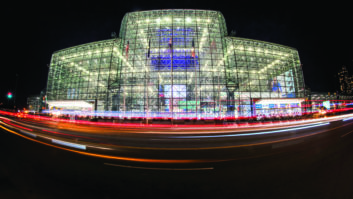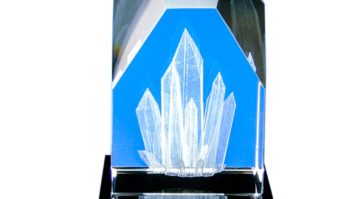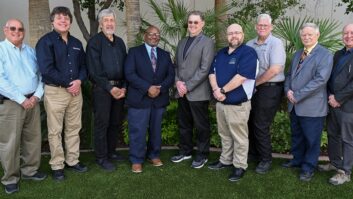IT convergence, data management, systems integration, IP applications.
Not new issues for radio engineers.
But the subjects are front and center as they prepare for NAB2007 and as they evaluate and implement new operations for stations in the digital broadcasting era while still broadcasting in the day-to-day reality of analog.
Transformation stage
“The industry is in a transformation stage,” said Michael Gay, national project manager of HD Radio and IT for Cumulus Media Inc. “There are very few opportunities to build from the ground up. More often than not, you are shoehorning the new into the old and dealing with how you can tackle those issues.”
Gay’s comments reflect a general trend in how radio engineers are thinking and planning as the NAB spring show approaches.
Cumulus has been “full speed ahead” at implementing HD Radio for the last two years, he said. With almost 350 stations in the group, approximately 50 are broadcasting HD, and he said 30 are planned to go online by the end of the year. Gay said all the regional engineers probably will be at NAB.
“I want to see how products that we saw last year, which were in the development stage, have come to fruition,” Gay said. “I also want to see what’s new.”
Consoles, digital routers, IT gear — the list goes on for Gay.
“I’m always looking for something that is going to make things more efficient,” he said. “You have to pick the right products to make things easier.”
Milford Smith, vice president of Radio Engineering for Greater Media Inc., said NAB2007 is “terribly important” from a technical perspective, with the accelerated implementation of HD Radio and all that is involved.
“I look upon the show as more critical than ever on the technical side,” he added.
Multicasting, VoIP, Web streaming
Issues Smith cites include multicasting with multiple channels, audio over IP, data applications with the potential for new revenue opportunities and Web site streaming.
“This is all pretty exciting,” he said.
Smith, past chairman of the NAB engineering conference and engineering advisory committees, will take on the role of presenter in a radio management session when he talks equipment in “Building an HD Station: From Studio to the Bank.” Smith also is chairman of the NAB Digital Radio Committee and senior co-chairman of the National Radio Systems Committee DAB subcommittee.
Smith said the show is an opportunity for owners and managers from all sizes of stations and ownership situations to learn more about digital.
“HD Radio can be intimidating,” Smith said. “What they’ve got to do and how much … These choices aren’t always obvious.” He’s also moderating the session “STL Bandwidth Requirements for Radio.”
The engineering and management sessions reflect technology developments that will be apparent on the exhibit floor.
Topics include audio over IP, RDS and the new RT+ that allows for better text support of artists and titles. Then there is the infrastructure required and the workflow setup; these are covered too.
Steve Fluker, director of engineering for six Cox Radio stations in Orlando, Fla., said among issues on his mind is multicasting, which he will be implementing in his market.
Also, he added, “A key issue people have to think about in implementing HD is how to get your data streams to the tower site.”
He expects all Cox Radio markets to be represented at NAB on the engineering side, some two layers deep.
One of the challenges Fluker noted for the industry is what managers expect from engineers and vice versa. “It’s a whole new world out there,” he said, adding there remains a division in engineering between what is IT and what is RF.
He’s moderating the sessions “RF Implementation for HD Radio” and “Surround Sound for Radio.”
Newsgathering for 2008
Don Danko, vice president of engineering and operations for Cincinnati Public Radio, will be looking up developments regarding high-power HD transmitters; he also will be checking out newsgathering as his stations, which number five, get ready for the 2008 presidential election.
Danko said he wants to see what is on the marketing for audio on IP and, among other gear, any new audio recorders.
He said CPR has used FTP transfer for audio files in the past, but they were small files. He does not think FTP will be sufficient the next time around.
“We are concerned about getting the news coverage ‘right,’” Danko said, technically as well as factually.
Danko believes product development is in line with how stations need to operate these days.
“I think flexibility is very important,” he said. “We have to get away from the proprietary nature of the equipment and systems.
“Cross-compatibility is important in engineering,” Danko said.
Open control and flexibility are evident in remote-control capabilities, he continued. “It’s starting to get really solid in the design and implementation.”
For Jay Goldman, director of engineering for WXPN, a AAA noncommercial station licensed to the University of Pennsylvania, transmission equipment is at the top of the list, both digital and analog.
He is looking at possibly replacing an analog transmitter and some ancillary equipment. But he said he also will be looking for a new HD processor for his system.
Goldman said that the operation is running smoothly. “Actually, it is moving along better than I thought it would,” he said.
“Our listeners are really curious about HD. Like anything with new technology, it will take some time.”
Clark Dixon, Clear Channel director of engineering in Tulsa, Okla., said he will be looking for some analog gear at NAB: a low-power, frequency agile backup transmitter solution to locate at the studio site. But otherwise HD is on his mind. “Things in that arena are changing very rapidly.”
The six Clear Channel stations in his market are transmitting HD Radio, and the four FMs are multicasting HD2. There were a few bumps getting stations online, Dixon said, but the problems were in the early stages.
Dixon said digital transmissions of all aspects are becoming critical for radio.
“The more convenient that we can make it for listeners to find and hear the programming that they already enjoy,” he said, “through streams, podcasting as well as the current broadcast method — we have a great guarantee that radio stays around for a long time to come.”
And John Mathews, vice president of engineering for Radio One, said his focus for NAB is HD, specifically multicasting and HD data services. He wants to investigate further services that offer listener interactivity.
But he added, “It is one thing to offer ‘neat’ services; it is another to make money with it.”
Of Radio One’s 70 stations, Mathews said 34 are on in HD Radio, and 17 more plan to be by year-end.
That brings him to his NAB shopping list for test equipment. “We have the stations online,” he said, “Now we are focusing on optimization.”












